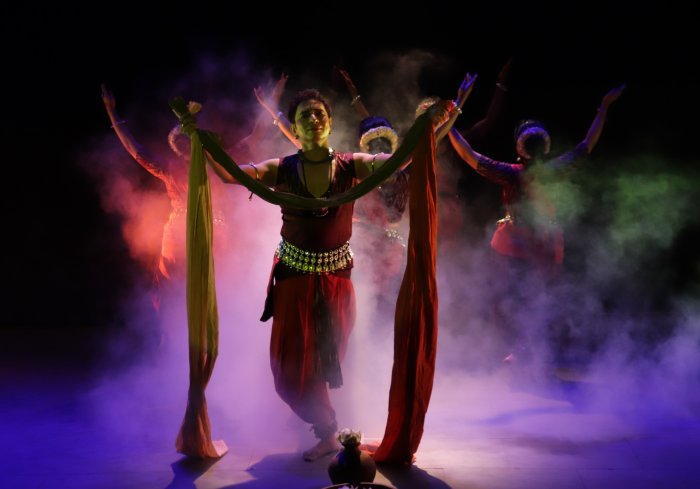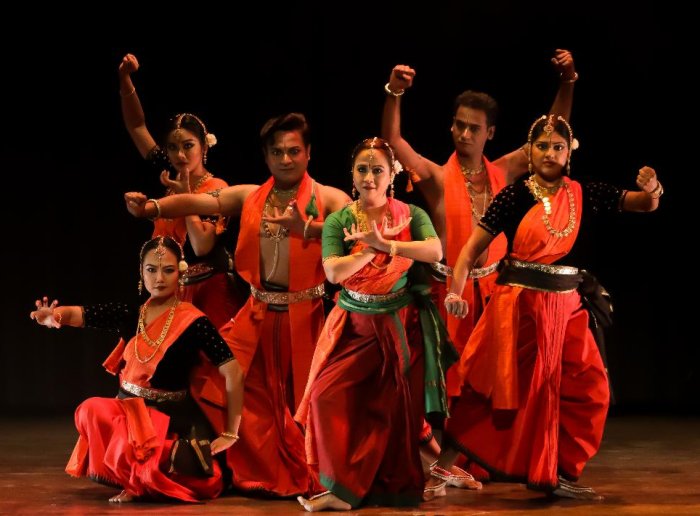
|   |

|   |
Hey Purushottam - Tapati Chowdhurie e-mail: tapatichow@yahoo.co.in May 25, 2022 May 13, 1856 changed the cultural history of Calcutta. It was the day when the deposed Nawab of Awadh, Wajid Ali Shah, a connoisseur of the arts, landed in the metropolis and spent his last 31 years here. He had brought to Calcutta the refined culture of Lucknow. Among other things he laid the foundation of Lucknow gharana Kathak in this metropolis. Besides being a well trained musician, Wajid Ali Shah was an accomplished Kathaka who was mentored by Thakur Prasad - the father of Kalka and Bindadin Maharaj. The Kathak history of Calcutta did not stop here; it was further enriched by Jailal Maharaj of Jaipur Gharanedar Kathak when he came to Calcutta nine decades later in 1946. He was a loving teacher and a performer, whose son Ramgopal Misra set up school in the city and taught aspirants the art of Kathak. It is therefore interesting to see that both Lucknow gharana and Jaipur gharana Kathak were taught in full swing in the city. Aspirants of Kathak in Calcutta got the opportunity to learn the best of both gharanas. Even to this day most of the Kathakars in the city are well versed in both the gharanas. Kathaka Ashimbandhu is likewise equally proficient in both Jaipur and Lucknow gharana of Kathak dance, having learnt the art from stalwarts like Pt Birju Maharaj, Pt Vijay Shankar - disciple of Birju Maharaj - and Pt Ramgopal Misra.  Ashimbandhu and group Recently Vivekananda Hall of Ramakrishna Mission Cultural Institute at Gol Park in Kolkata reverberated with the songs and spoken words of Swami Vivekananda and his divine Guru, Sri Ramakrishna Paramahansa. The Upasana Centre of Dance under the able guidance of its founder Kathak exponent Ashimbandhu Bhattacharjee presented 'Hey Purushottam,' their choreographic tribute to Swami Vivekananda scripted by Amit Das Gupta whose ability to express himself had photographically captured the nuances of the life of the great Master. Ashimbandhu's direction and sensitive choreography captured the spiritual glory of Swamiji through the dynamic vibrancy of Kathak. The all male team consisting of Subrata Pandit, Avik Chaki, Ayan Banerjee, Susanto Ghosh, Sandip Sarkar and Shuvradip Shaw - all excellent and experienced dancer-actors repeatedly created moments of awe. Ashimbandhu in the title role did justice to the form and to Swamiji. Navadisha - New Dimensions in Choreography Festival by Ashimbandhu Bhattacharjee's Upasana Centre of Dance was an added feather in his cap. The festival aimed at creating an ambience of a harmonious co-existence amongst all the forms of classical dances of India. This project held a torch to the continuous process of evolution and transformation of the dance forms, while staying true to their respective forms. This festival has been an ongoing endeavour of Ashimbandhu for more than a decade and he has showcased path-breaking works of artistes like Rajendra and Nirupama (Kathak) of Bengaluru , Sharmila Biswas (Odissi) of Kolkata, Ratikant Mohapatra (Odissi) of Odisha, Anita Mullick (Bharatnatyam) of Kolkata, Vidhi Nagar (Kathak) of Varanasi. Almost all the dances in India are deeply religious in content. It contains the moral truths and the cardinal principles laid down by the sages and the shastras. The choreographers who were invited to perform in this festival had to delve into the long established, time-honoured principles, our myths, legends and history albeit with a different approach. Ashimbandhu is of the opinion that the responsibility of every artiste is to update their tradition creatively. This year artistes from Kolkata were invited to showcase their innovative choreographic works. Kathak artistes Sandip Mallick, Subrata Pandit and Ashimbandhu himself, Bharatanatyam practitioners Samrat Dutta, Rajdeep Banerjee, Contemporary dance choreographer Soma Giri, Odissi dance performer/teacher Arnab Bandopadhyay, Manipuri dancer Bimbavati Devi were the chosen artistes. The presentations were in Rabindranath Tagore Auditorium of ICCR. The students of Upasana Centre for Dance presented Guru Vandana followed by the choreographic presentation of Sandip Mullick who is known for exploring fresh avenues to extend the boundaries of Kathak. Pratyasha is Sandeep Mallick's 'Hope' and it is the 'Hope' of all mankind to get back our normal lives and do away with the restrictions imposed on us by the pandemic. The presentation was based on a poem by Rupasree Mallick, a down-to-earth theme, which has been affecting our lives.  Samrat Dutta and group Bharatanatyam practitioner / teacher Samrat Dutta presented Angamantra Parashakti-a selected piece from his well researched choreographic work Dasamahavidya in Sanskrit which depicts the ten forms of Parashakti according to tantra theory. Number 'ten' is an important number in the lives of human beings. According to ancient records mathematics did not discover the value of 'zero.' Zero was Aryabhatta's contribution to mathematics. On the other hand, the Dasadishi, the Dasakarma, the Dasamandala, the Dasavatarams are all related closely to human lives -incidentally a foetus also lives in the mother's womb for ten months and ten days before taking birth. 'Dasamahavidya' is not only the description of the dhyana mantras of the ten Devis such as Kamala, Kali, Tara, Vagala, Bhairavi, Bhuvaneswari, Dhumavati, Matangi, Chinnamasta and Shodashi, but it is the reflection of the ultimate human life, human emotions and are the stages through which man advances slowly and gradually towards his ultimate completeness. A very complicated theme for ordinary mortals to grasp, it was set by Samrat to Dasa-ragamalika and talamalika. Subrata Pandit's offering was Paramparya. The Gita quite aptly describes a Guru to be one who dispels darkness. The disciple takes refuge at the feet of the guru to get salvation. In the individual's quest it's the guru who shows him the path. A guru is the medium through whom the disciple comes to know the ultimate truth. Subrata Pandit delved deep into this theme. Arresting the attention of the audience and leading them on was a difficult task, which perhaps needed more experience. It was a difficult theme executed bravely, but needed more research and thinking. Considering the fact that much of the theme was abstract the audience had problem in identifying themselves with it. Soma Giri's work 'Silence' showcased the turmoils of life. Silence is a powerful word and expression of it is no cake walk. She brought home the truth through Contemporary style of dance that 'Silence' is louder than words to showcase the emotions of life. Her movements were neatly chiselled and practised to perfection. In the second segment of the program, Spring was welcomed by the students of Upasana Centre for Dance followed by Rajdeep Banerjee's offerings of 'Ram Ram' - which he used as a metaphor to mean 'the light within me' in Bharatanatyam style. 'Ram Ram' symbolized reason, right action and desired virtues used as a greeting. The topic smells of intense bhakti towards Ram - one who frees you from the worldly sorrow or pain. That which affirms love, compassion, wisdom and truth, Shree Ram contemplates a progression, a drop of which purifies our entire soul. He is the means and he is the end himself. He is a transcendent who defines our journey from mortality to divinity. The piece had an overdose of pontification. Mythological stories have immense scope and capacity to draw analogies and a powerful choreographer reaps the benefit.  Arnab Bandopadhyay and group Arnab Bandopadhyay's Darpani presented Ananta/Eternity which is an innovative production in Odissi style. Ananta is an exploration of some of the most profound philosophical concepts from the ancient Vedas and Upanishads. Arnab Bandopadhyay used techniques of Odissi along with creative movements, classical music and Vedic chanting to express the idea. Though the theme was as ancient as it probably could be, it was rather interesting to observe that the choreographer has used modern creative dance to express the concept of Panchabhuta or five elements. The script of Sreyashi Dey has taken into account the scientific journey of Panchabhuta (not being equipped with scientific knowledge, was in no position to judge the veracity of its traverse at the Paramanu level). Sandipan Ganguly's music accompaniment added to the beauty of the piece. Manipuri performer /teacher Bimbavati Devi used the wisdom to be found in Gitopadesham where Krishna tells Arjuna that whenever evil besets the world, he comes to redeem mankind. Her choreographic work 'Purna Purushottam' is a celebration of Vishnu in the form of Narasimha when he redeems mankind by annihilating the evil Hiranyakashipu. Artistes of Manipuri Nartanalaya and Bimbavati Devi herself enacted this scene so dramatically that the audience sided with Narasimha avatar and came back to the real world only after the demon king Hiranyakashipu's stomach was ripped open by the Narasimha avatar of Sri Krishna. Powerful dance moments were created with tandava style and the martial arts of Manipur by a set of stage worthy performers who touched the hearts of dance lovers present.  Bimbavati Devi and group The grand finale was by five high powered male dancers, the disciples of Ashimbandhu Bhattacharjee in the concept of Fire written in the latter half of 8th century by the Greek poet Hesiod. Prometheus had sneaked into the forbidden domains of the gods to steal fire -a symbol of power for mortals - for which he was punished to lead a life of torment which he bore with fortitude. Power which is an attribute of god came to be possessed by human beings. A powerful and unusual theme of the past was dealt with maturity by the experienced Kathaka. The performers Sandip Sarkar, Ayan Banerjee, Avik Chaki, Sourav Roy, Subrata Pandit and Ashimbandhu Bhattacharjee ushered in an aura of mysticism, pirouetting endlessly like dervishes while through their tatkar they brought out their meditative spirit. Music composition of Sunando Mukherjee and light designer Dinesh Poddar proved their importance in the production of a dramatic story communicated with Úlan.  Tapati Chowdurie trained under Guru Gopinath in Madras and was briefly with International Centre for Kathakali in New Delhi. Presently, she is a freelance writer on the performing arts. |